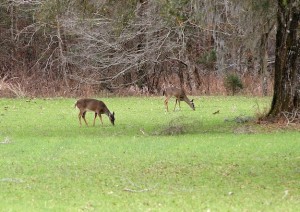DMAP program to offer leeway in anterless deer limits
By DAVID RAINER
Alabama Department of Conservation and Natural Resources
While manning the Outdoor Alabama booth at the Rick and Bubba Outdoor Expo in Birmingham over Father’s Day weekend, I observed what I pretty much already knew: Alabama is a deer-hunting state.
The observation came from the free magazines we offered at the booth with various cover photos. Without a doubt, the magazine that disappeared the quickest was the one with a big whitetail buck on the cover.
So, in the middle of summer, Alabama folks are still thinking about deer, which is why Chuck Sykes, Director of the Alabama Wildlife and Freshwater Fisheries (WFF) Division, wants landowners and hunting clubs to reconsider a program that has been available for many years – the Deer Management Assistance Program (DMAP).

At the final Alabama Conservation Advisory Board meeting of the year, the board voted to reduce the antlerless deer harvest to one per day statewide. However, landowners and lease holders can gain some leeway on the antlerless deer bag limit through DMAP, which will be updated with new features for the 2015-2016 season.
“We need to let people know DMAP is still available for those who need to harvest more than one antlerless deer per day,” Sykes said.
The reason Sykes and WFF officials decided to propose a reduction in antlerless deer harvest was a result of “town hall” meetings conducted last year to discuss the Game Check program.
“For me, it was traveling all over the state last year at the public meetings and listening to the concerns of hunters throughout the state,” Sykes said. “And it was talking with our biologists, who were experiencing the same topics of conversation with hunters. And what we were seeing in the field. Deer numbers are down a little bit.”
Sykes said there could be numerous reasons for the reduction in the deer numbers.
“In some areas, it could be predator issues,” he said. “In certain locations, it might be overharvest. In certain locations, it could be habitat quality changes and it just can’t support as many deer. And you’ve got competition for resources with feral hogs in certain areas.
“So the logical thing to do is reduce the statewide bag limit on antlerless deer but also allow people in areas where their numbers are good to participate in the Deer Management Assistance Program, and they can harvest up to three antlerless deer per day if they want.”
Sykes said WFF was not the only entity to reduce the deer harvest.
 “The National Forests went a step further and reduced their bag limit to one deer per day,” he said. “You’ve got to take your pick – either a buck or a doe. They were concerned about lower deer numbers, so this is not just coming from us.
“The National Forests went a step further and reduced their bag limit to one deer per day,” he said. “You’ve got to take your pick – either a buck or a doe. They were concerned about lower deer numbers, so this is not just coming from us.
“What I want people to take away from this is if you’ve done your job and you’ve got plenty of deer, that habitat is in good shape, the predators are under control, and you need to harvest more than one antlerless deer per day, there is a way to do it.”
About 15 to 20 years ago, landowners and lease holders utilized the DMAP program considerably more than in recent years. Sykes said the reason DMAP hasn’t remained a priority is pretty simple.
“Liberalized doe harvest came about,” he said. “Why would you participate in DMAP when 90 percent of what people were participating in DMAP for was to shoot more does.
“That’s why we are revamping the DMAP program.”
Jerremy Ferguson of Cullman, a WFF wildlife biologist, has been charged with the DMAP overhaul.
“The idea is to retool it instead of it being just a doe-tag system,” Ferguson said. “We’re looking at creating a program to give deer managers and hunters a way to manage deer and all wildlife with an all-inclusive program. We’re not just focusing on does like DMAP did in the past. We’re going to take a closer look and be a lot more rigorous in the approach in terms of what we’re going to ask the participants to do. In the past, all we asked them to do was provide us with deer harvest and observational data. Our biologists would look at the habitat.
“We want participants to improve their habitat and deer herd population dynamics. That will also be beneficial for various other species. In the past, Alabama hasn’t pushed the management of small game as much in their deer management program, but we are going to try to involve various other species.”
Ferguson said the specifics of the revamped DMAP are still being worked out, and one question is whether a WFF biologist must be involved in the program or whether a certified biologist hired by the landowner or club could monitor the program with oversight from WFF biologists.
Ferguson said the revamped DMAP will start to be unveiled for 2015-2016 season, but he doesn’t want people to wait until then to sign up.
“The current DMAP is still available, and we’re encouraging people to enroll in it,” he said. “That way they can get us the needed observation data and have a leg up for what they’re going to need to get started for the next version. That’s going to be very important.
“The current version is not all that rigorous. Our vision for the next version is going to have multiple tiers. Each time you climb a tier, the requirements will be more rigorous. That’s our vision for acreage and habitat requirements.
Ferguson foresees tiers that take into consideration ownership patterns, which include private landowners like timber companies where extensive habitat management is not possible, small landowners with patchwork property like in much of north Alabama, as well as private landowners with considerable property where an all-encompassing land management program is feasible.
“We’re working with other state agencies and with the team here at Wildlife and Freshwater Fisheries to hammer out what’s really going to work,” he said.
Sykes and Ferguson said people interested in DMAP need to contact their district office and get signed up for the program as soon as possible.
“We’re asking people to sign up now because, if there is a rush in September, we may not be able to get to everybody before the season starts,” Sykes said.
David Rainer is a columnist for Outdoor Alabama.
